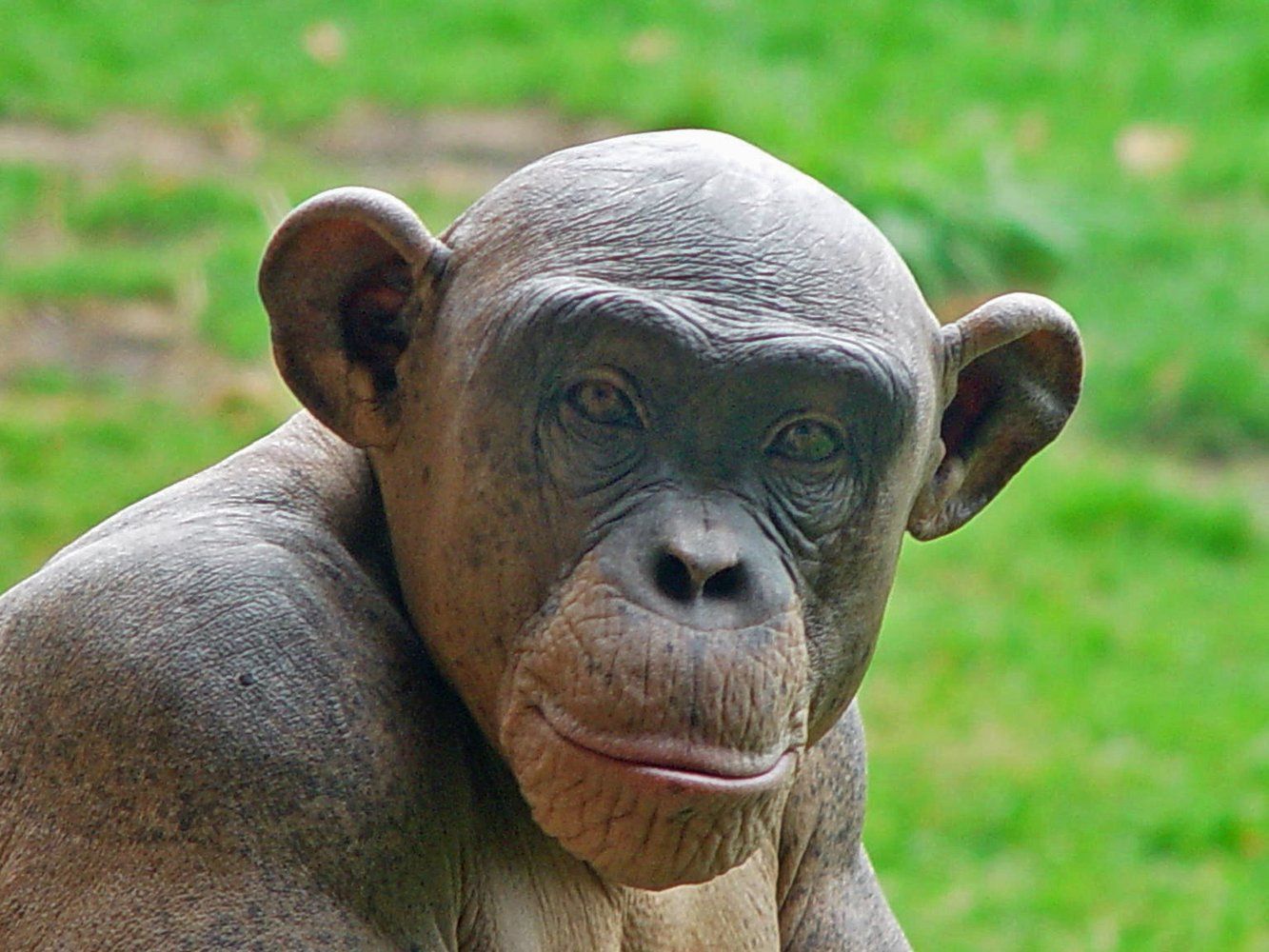Table Of Content

Consequently, hominins must have been bipedal from the very beginning. Hairless chimpanzees have a genetic mutation resulting in their bodies’ absence of hair. This mutation affects the development of hair follicles, which normally produce hair. Regular veterinary visits should be a part of your chimp's life. And it's important to find a veterinarian who has ample experience dealing with chimps. Heart disease, dental disease, and diabetes are all common illnesses that pet chimpanzees are prone to.
What are Hairless Chimpanzees?
Staff at the zoo will carry out a full post-mortem examination after early checks revealed he also had some signs of heart disease. Early in life he had to work hard to be accepted but was recently an integral part of the strict hierarchy, headed by his father. Despite being hairless - inherited from his equally smooth father Jambo - Mongo was a hit in his group.
Chimpanzees go almost completely BALD after 'tearing each other's hair out' at German zoo with staff blaming ' - Daily Mail
Chimpanzees go almost completely BALD after 'tearing each other's hair out' at German zoo with staff blaming '.
Posted: Wed, 20 Mar 2024 07:00:00 GMT [source]
Habitat
Disease outbreaks are another significant threat to hairless chimpanzees in the wild. Hairless chimpanzees may be more susceptible to infections and diseases transmitted from humans and other animals without fur protection. This is particularly concerning given the current global pandemic caused by the SARS-CoV-2 virus, which has already been shown to infect other great apes in the wild. Hairless chimpanzees are also at risk of poaching and illegal wildlife trade, a major problem in many parts of their range. Hunters often target hairless chimpanzees because of their unique appearance, and their rarity makes them a valuable commodity on the black market. The illegal wildlife trade is a multi-billion dollar industry decimating populations of many species, including hairless chimpanzees.
Hairless Hamster
This type of baldness is partly caused by the fact that humans have continuously growing hair, something most other mammals don’t have (poodles are an exception to this rule, Nuttall says). Only with stumptailed macaques, the condition does not distinguish between males and females–both sexes experience a type of eight-ball baldness in their old age. The chimpanzee lives in groups that range in size from 15 to 150 members, although individuals travel and forage in much smaller groups during the day.
Chimps ripping out each other's hair, revealing their muscular physiques, in baffling scene at German zoo - New York Post
Chimps ripping out each other's hair, revealing their muscular physiques, in baffling scene at German zoo.
Posted: Wed, 20 Mar 2024 07:00:00 GMT [source]
Can Animals Live Without Fur?
After a few months of rest and veterinary care, Henry was ready for the next phase of his recovery. However, we do not guarantee individual replies due to the high volume of messages. "There's a lot of work done on trying to understand physiology and maybe how to override it," Dr. Bradley said.

Adult chimps are much stronger than most humans, so an unruly chimp may easily harm—or even kill—its owner. We are grateful for those organizations who supported our rescue of the Wildlife Waystation chimpanzees. Between 2019 and 2023, the Chimpanzees In Need fundraiser raised over $4.7M and succeeded in rehoming all the chimpanzees to accredited facilities, where they are thriving. Our emergency effort to rescue chimpanzees at the Wildlife Waystation was a huge success, but our commitment to help chimpanzees continues. A campaign led by NAPSA focused on securing sanctuary homes for captive chimpanzees.
Field study
Additionally, being hairless may make it easier for chimpanzees to groom each other, as there is less fur to navigate. You also must be sure you'll be able to manage your chimp as it grows in strength and keep it safely contained on your property. There have been cases of pet chimps escaping their enclosures and attacking people.
Body
Even after bipedalism was established, the charming breasts were most probably effective at maintaining hairlessness positively. In chimpanzee societies, social status and hierarchies play a significant role in their behavior and interactions. Hairlessness can impact a chimpanzee’s social status within its group, both positively and negatively. In some cases, hairlessness can result in a unique appearance that may draw attention from others, potentially elevating the hairless individual’s social status. On the other hand, hairlessness can also make individuals more vulnerable to aggression and social exclusion, particularly in cases where the lack of hair is viewed as a physical abnormality.
From the start, they could see he was friendly and liked people—a miracle in light of what he had suffered throughout his life. Henry was rescued in 2009 when animal control officers found him in a rusty cage in a garage in Houston, Texas. For 15 years, he had existed like this, living as a “pet.” It was reported that in his early years he was moved from owner to owner and was known to have been badly abused.
In zoos, chimp enclosures often include both real and man-made trees, ropes, and suspended nets on which resident chimpanzees can play and exercise. These are the sorts of environments that give captive chimps the physical activity they need to stay healthy and happy. But once they reach adulthood, chimps can become quite physical and demanding, leaving many chimp owners unable to control their animals. Even when raised in captivity, they retain their wild instincts, making them unpredictable. Their moods can change from friendly to violent without an obvious trigger, and they will swing their limbs and bite out of aggression.
Chimpanzees live in fluid communities without monogamous mating bonds. Females may move between communities in search of new partners or to defend their territory. The article briefly mentions fish, their intelligence, tool usage, and medicine creation. Dean and Siva-Jothy suggest that hair loss did help to reduce the risk of parasites, but that total loss would have made things worse. There’s an optimal length of fuzz where parasites are easiest to spot, and we might have hit upon it.
Animal hair can be lost through a number of different mechanisms, from temporary damage due to hair being scratched out to more permanent damage from trauma. These include fungal infections like ringworm, parasitic mites that cause mange or “anything that’s inflammatory or infectious that would destroy the hair follicles,” says Nuttall. Ringworm directly damages the hair shaft while in a case particular to hedgehogs, mites feed around the base of the spines, causing the follicle opening to widen so that the spines fall out. Balding men don't actually lose hair; the hairs just become progressively smaller until they are microscopic, the same way they are at birth.
Chimpanzees usually show aggression towards humans as a sign of dominance. Yes, animals can live without fur, and there are several examples across various species where a lack of fur is a natural and adaptive feature. For example, the Sphynx cat is a breed known for its nearly hairless appearance. This cat breed has a genetic mutation that results in minimal coat development.
The species lives in a strict male-dominated hierarchy, where disputes are generally settled without the need for violence. Nearly all chimpanzee populations have been recorded using tools, modifying sticks, rocks, grass and leaves and using them for hunting and acquiring honey, termites, ants, nuts and water. The species has also been found creating sharpened sticks to spear small mammals. The infant is weaned at about three years old but usually maintains a close relationship with its mother for several years more.
Their distinctive mode of travel—walking on the sole of each foot and the knuckles of their hands—have earned them the title of knuckle-walkers. The Peruvian Inca orchid, sometimes nicknamed the PIO, is Peru’s official dog, and it can be hairless or coated. As sighthounds—like greyhounds, whippets, and borzois—the dogs are bred to hunt by sight rather than scent. The uakari’s face certainly is expressive, and it often seems to look worried. Maybe that’s because hunting and habitat loss has caused their numbers to drop by 30 percent in as many years, giving it vulnerable status on the IUCN Red List of Threatened Species. These questions only brush the surface of what it means to be the owner of a chimp.
Some have theorized that facial redness is a signal of good health, a theory Bowler is in the process of testing. Hairless faces on monkeys, he said, may aid visual communication. For the most part, though, expect to have your chimp with you or someone in your household the majority of the time to fulfill its social and activity needs.














